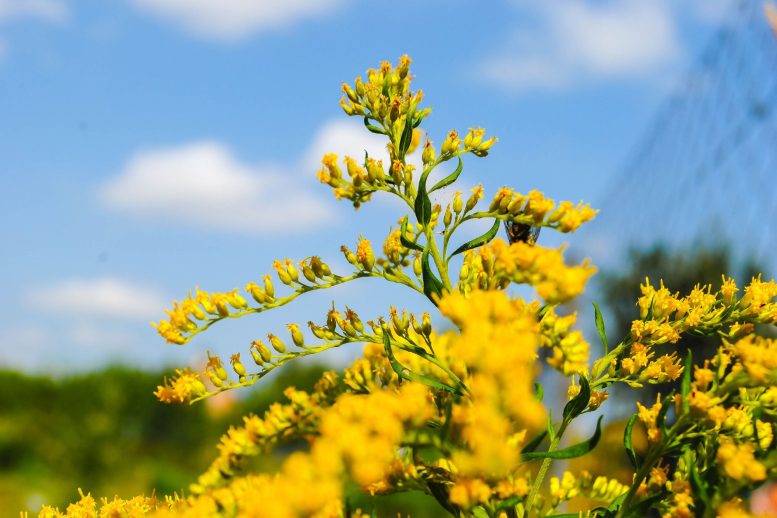

Goldenrod plants can sense other nearby plants through far-red light ratios and adapt their responses when eaten by herbivores, suggesting a form of plant intelligence. Andre Kessler, a chemical ecologist, defends plant intelligence by defining it as the ability to solve problems based on environmental information. His research shows that goldenrod releases chemicals to signal neighboring plants to produce defenses against pests. This adaptive behavior and communication through VOCs suggests that plants can process information and respond flexibly to their environment, challenging traditional notions of intelligence. Credit: SciTechDaily.com
New research shows that goldenrod plants exhibit a form of intelligence by adapting their responses to herbivores based on the presence of nearby plants and environmental cues, challenging traditional definitions of intelligence.
Goldenrod can see other plants nearby without ever touching them, by sensing the proportions of far-red light reflected off the leaves. When herbivores eat a goldenrod, they adapt their response based on whether or not there is another plant nearby. Is this kind of flexible, adaptive, real-time response a sign of intelligence in plants?
It’s not an easy question to answer, but Andre Kessler, a chemical ecologist, made an argument for plant intelligence in a recent paper in the journal Plant signals and behavior.
Definition of intelligence in plants
“There are more than 70 published definitions of intelligence and no agreement on what it is, even within a specific field,” said Kessler, a professor in the Department of Ecology and Evolutionary Biology in the College of Agriculture and Life Sciences.
Many people believe that intelligence requires a central nervous system, in which electrical signals act as a medium for processing information. Some plant biologists associate a plant’s vascular systems with the central nervous system, and suggest that some sort of central entity in the plant allows them to process and respond to information. But Kessler strongly disagrees with this idea.

Goldenrod plant.
“There is no good evidence for any homologs with the nervous system, although we clearly see electrical signals in plants, but the question is how important is this signal to a plant’s ability to process environmental signals?” He said.
To make their argument for plant intelligence, Kessler and co-author Michael Mueller, a doctoral student in his lab, narrowed their definition down to the most basic elements: “the ability to solve problems, based on information you get from the environment.” “Towards a certain goal,” Kessler said.
As a case study, Kessler points to his previous research looking at goldenrod plants and their responses when eaten by pests. When leaf beetle larvae eat the leaves of a goldenrod plant, the plant secretes a chemical that tells the insect that the plant is damaged and is a poor source of food. These airborne chemicals, called volatile organic compounds (VOCs), are also picked up by neighboring goldenrod plants, prompting them to produce their own defenses against the beetle larvae. In this way, goldenrod transports herbivores to neighbors and distributes the damage.
Experiments and observations
in Paper 2022 In the magazine the plants, Kessler and co-author Alexander Chota, Ph.D. In 2121, he conducted experiments to show that goldenrod could also perceive higher proportions of far-red light reflected from the leaves of nearby plants. When neighbors are present and beetles eat goldenrods, they invest more in tolerating herbivores by growing faster but also begin producing defensive compounds that help plants resist insect pests. In the absence of neighbours, plants do not resort to exponential growth when they are eaten and the chemical responses of herbivores differ markedly, although they can still tolerate very large amounts of herbivory.
“This fits our definition of intelligence,” Kessler said. “Depending on the information it receives from the environment, the plant changes its standard behavior.”
Neighboring goldenrod also show intelligence when they see VOCs that indicate the presence of a pest. “Volatile emissions coming from a neighbor are predictive of future herbivores,” Kessler said. “They can use an environmental signal to predict the future situation, and then act accordingly.”
Applying the concept of intelligence to plants could inspire new hypotheses about the mechanisms and functions of plant chemical communication, while also changing people’s thinking about what intelligence really means, Kessler said.
The last idea came at the right time, as well artificial intelligence It is the subject of current interest. For example, he said, AI is not solving problems toward a goal, at least not yet. “Artificial intelligence, by our definition of intelligence, is not even intelligent,” he said. Instead, it relies on patterns it identifies in the information it has access to.
The idea that interested Kessler came from mathematicians in the 1920s, who suggested that plants might function more like beehives. In this case, each hive acts like an individual bee, and the entire plant resembles a beehive.
“What that means is that the brain in the plant is the entire plant without the need for central coordination,” Kessler said.
Instead of electrical signals, there are chemical signals throughout the superorganism. Studies by other researchers have shown that each plant cell has broad-spectrum light perception and sensory molecules to detect very specific volatile compounds coming from neighboring plants.
“They can smell their environment very precisely; every cell can do that, as far as we know.” The cells may be specialized, but they also all perceive the same things, communicating via chemical signals to stimulate a collective response in growth or metabolism. “This idea Very attractive to me.”
Reference: “Induced resistance to herbivores and intelligent plants” by Andre Kessler and Michael B. Mueller, April 30, 2024, Plant signals and behavior.
doi: 10.1080/15592324.2024.2345985
This paper was supported by a grant from the New Botanists Fund.

“Web maven. Infuriatingly humble beer geek. Bacon fanatic. Typical creator. Music expert.”





More Stories
SpaceX launches 23 Starlink satellites from Florida (video and photos)
A new 3D map reveals strange, glowing filaments surrounding the supernova
Astronomers are waiting for the zombie star to rise again